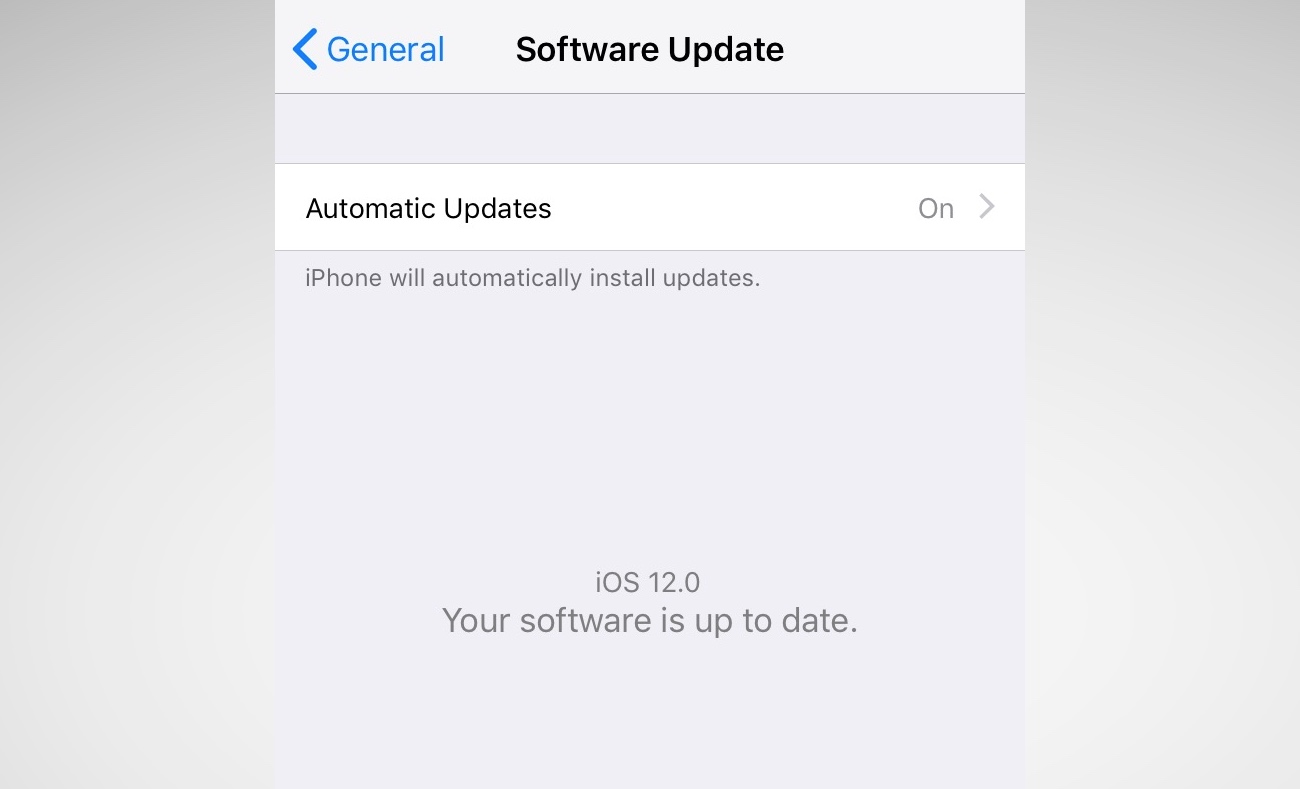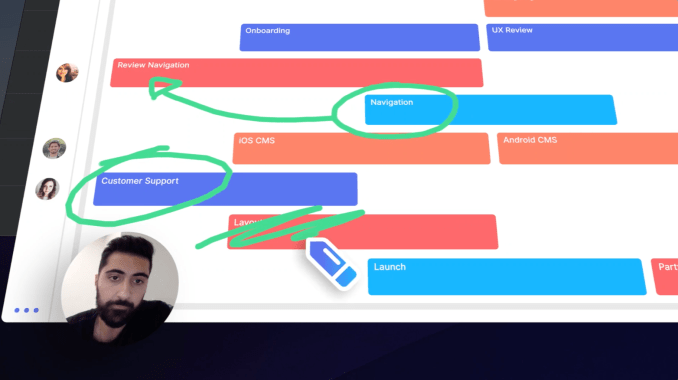Cybersecurity 101: Five settings to secure your iPhone or iPad
iOS 12, Apple’s latest mobile software for iPhone and iPad, is out. The new software packs in a bunch of new security and privacy features you’ve probably already heard about. Here’s what you need to do to take advantage of the new settings and lock down your device.
1. Turn on USB Restricted Mode to make hacking more difficult

This difficult-to-find new feature prevents any accessories from connecting to your device — like USB cables and headphones — when your iPhone or iPad has been locked for more than an hour. That prevents police and hackers alike from using tools to bypass your lock screen passcode and get your data.
Go to Settings > Touch ID & Passcode and type in your passcode. Then, scroll down and ensure that USB Accessories are not permitted on the lock screen, so make sure the setting is Off. (On an iPhone X, check your Face ID settings instead.)
2. Make sure automatic iOS updates are turned on

Every time your iPhone or iPad updates, it comes with a slew of security patches to prevent crashes or data theft. Yet, how often do you update your phone? Most don’t bother unless it’s a major update. Now, iOS 12 will update your device behind the scenes, saving you downtime. Just make sure you switch it on.
Go to Settings > General > Software Update and turn on automatic updates.
3. Set a stronger device passcode

iOS has gotten better in recent years with passcodes. For years, it was a four-digit code by default, and now it’s six-digits. That makes it far more difficult to run through every combination — known as brute-forcing.
But did you know that you can set a number-only code of any length? Eight-digits, 12 — even more — and it keeps the number keypad on the lock screen so you don’t have to fiddle around with the keyboard.
Go to Settings > Touch ID & Passcode and enter your passcode. Then, go to Change password and, from the options, set a Custom Numeric Code.
4. Now, switch on two-factor authentication

Two-factor is one of the best ways to keep your account safe. If someone steals your password, they still need your phone to break into your account. For years, two-factor has been cumbersome and annoying. Now, iOS 12 has a new feature that auto-fills the code, so it takes the frustration step out of the equation — so you have no excuse.
You may be asked to switch on two-factor when you set up your phone. You can also go to Settings and tap your name, then go to Password & Security. Just tap Turn on Two-Factor Authentication and follow the prompts.
5. While you’re here… change your reused passwords

iOS 12’s password manager has a new feature: password auditing. If it finds you’ve used the same password on multiple sites, it will warn you and advise you to change those passwords. It prevents password reuse attacks (known as “credential stuffing“) that hackers use to break into multiple sites and services using the same username and password.
Go to Settings > Passwords & Accounts > Website & App Passwords and enter your passcode. You’ll see a small warning symbol next to each account that recognizes a reused password. One tap of the Change Password on Website button and you’re done.
Powered by WPeMatico
Samsung’s foldable phone? Meet the Galaxy Fold
Samsung’s promised a much better look at its foldable phone at tomorrow’s big S10 event. We already caught a glimpse of the product late last year at the company’s developer conference, but among the many uncertainties with the product is what the hell the company will name the thing.
After all, the device essentially represents an entirely new category for Samsung, so older naming conventions could be out the window. The “Galaxy F” name has been floated, but, well, nobody wants that.
Samsung Galaxy Fold
— Evan Blass (@evleaks) February 19, 2019
Perennial leaker Evan Blass (who most recently has helped expose the S10 to the world in recent months) says the handset will be the Galaxy Fold. Not bad, I guess. Probably one to go on — certainly a step up from the Galaxy F, which is, frankly, a bit too easily mocked.

So we have a name — and we should be getting more information on the thing tomorrow. And not a moment too soon, as we expect numerous foldable handsets to get some serious stage time next week at Mobile World Congress.
Powered by WPeMatico
Google acquires cloud migration platform Alooma
Google today announced its intention to acquire Alooma, a company that allows enterprises to combine all of their data sources into services like Google’s BigQuery, Amazon’s Redshift, Snowflake and Azure. The promise of Alooma is that it handles the data pipelines and manages them for its users. In addition to this data integration service, though, Alooma also helps with migrating to the cloud, cleaning up this data and then using it for AI and machine learning use cases.
“Here at Google Cloud, we’re committed to helping enterprise customers easily and securely migrate their data to our platform,” Google VP of engineering Amit Ganesh and Google Cloud Platform director of product management Dominic Preuss write today. “The addition of Alooma, subject to closing conditions, is a natural fit that allows us to offer customers a streamlined, automated migration experience to Google Cloud, and give them access to our full range of database services, from managed open source database offerings to solutions like Cloud Spanner and Cloud Bigtable.”
 Before the acquisition, Alooma had raised about $15 million, including an $11.2 million Series A round led by Lightspeed Venture Partners and Sequoia Capital in early 2016. The two companies did not disclose the price of the acquisition, but chances are we are talking about a modest price, given how much Alooma had previously raised.
Before the acquisition, Alooma had raised about $15 million, including an $11.2 million Series A round led by Lightspeed Venture Partners and Sequoia Capital in early 2016. The two companies did not disclose the price of the acquisition, but chances are we are talking about a modest price, given how much Alooma had previously raised.
Neither Google nor Alooma said much about what will happen to the existing products and customers — and whether it will continue to support migrations to Google’s competitors. We’ve reached out to Google and will update this post once we hear more.
Update. Here is Google’s statement about the future of the platform:
For now, it’s business as usual for Alooma and Google Cloud as we await regulatory approvals and complete the deal. After close, the team will be joining us in our Tel Aviv and Sunnyvale offices, and we will be leveraging the Alooma technology and team to provide our Google Cloud customers with a great data migration service in the future.
Regarding supporting competitors, yes, the existing Alooma product will continue to support other cloud providers. We will only be accepting new customers that are migrating data to Google Cloud Platform, but existing customers will continue to have access to other cloud providers.
Alooma’s co-founders do stress, though, that “the journey is not over. Alooma has always aimed to provide the simplest and most efficient path toward standardizing enterprise data from every source and transforming it into actionable intelligence,” they write. “Joining Google Cloud will bring us one step closer to delivering a full self-service database migration experience bolstered by the power of their cloud technology, including analytics, security, AI, and machine learning.”
Powered by WPeMatico
Medal.tv’s clipping service allows gamers to share the moments of their digital lives
As online gaming becomes the new social forum for living out virtual lives, a new startup called Medal.tv has raised $3.5 million for its in-game clipping service to capture and share the Kodak moments and digital memories that are increasingly happening in places like Fortnite or Apex Legends.
Digital worlds like Fortnite are now far more than just a massively multiplayer gaming space. They’re places where communities form, where social conversations happen and where, increasingly, people are spending the bulk of their time online. They even host concerts — like the one from EDM artist Marshmello, which drew (according to the DJ himself) roughly 10 million players onto the platform.
While several services exist to provide clips of live streams from gamers who broadcast on platforms like Twitch, Medal.tv bills itself as the first to offer clipping services for the private games that more casual gamers play among friends and far-flung strangers around the world.
“Essentially the next generation is spending the same time inside games that we used to playing sports outside and things like that,” says Medal.tv’s co-founder and chief executive, Pim DeWitte. “It’s not possible to tell how far it will go. People will capture as many if not more moments for the reason that it’s simpler.”
The company marks a return to the world of gaming for DeWitte, a serial entrepreneur who first started coding when he was 13 years old.
Hailing from a small town in the Netherlands called Nijmegen, DeWitte first reaped the rewards of startup success with a gaming company called SoulSplit. Built on the back of his popular YouTube channel, the SoulSplit game was launched with DeWitte’s childhood friend, Iggy Harmsen, and a fellow online gamer, Josh Lipson, who came on board as SoulSplit’s chief technology officer.
At its height, SoulSplit was bringing in $1 million in revenue and employed roughly 30 people, according to interviews with DeWitte.
The company shut down in 2015 and the co-founders split up to pursue other projects. For DeWitte that meant a stint working with Doctors Without Borders on an app called MapSwipe that would use satellite imagery to better locate people in the event of a humanitarian crisis. He also helped the nonprofit develop a tablet that could be used by doctors deployed to treat Ebola outbreaks.
Then in 2017, as social gaming was becoming more popular on games like Fortnite, DeWitte and his co-founders returned to the industry to launch Medal.tv.
It initially started as a marketing tool to get people interested in playing the games that DeWitte and his co-founders were hoping to develop. But as the clipping service took off, DeWitte and co. realized they potentially had a more interesting social service on their hands.
“We were going to build a mobile app and were going to load a bunch of videos of people playing games and then we we’re going to load videos of our games,” DeWitte says.
The service allows users to capture the last 15 seconds of gameplay using different recording mechanisms based on game type. Medal.tv captures gameplay on a device and users can opt-in to record sound as well.
“It is programmed so that it only records the game,” DeWitte says. “There is no inbound connection. It only calls for the API [and] all of the things that would be somewhat dangerous from a privacy perspective are all opt-in.”
There are roughly 30,000 users on the platform every week and around 15,000 daily active users, according to DeWitte. Launched last May, the company has been growing between 5 percent and 10 percent weekly, according to DeWitte. Typically, users are sharing clips through Discord, WhatsApp and Instagram direct messages, DeWitte said.
In addition to the consumer-facing clipping service, Medal also offers a data collection service that aggregates information about the clips that are shared by Medal’s users so game developers and streamers can get a sense of how clips are being shared across which platform.
“We look at clips as a form of communication and in most activity that we see, that’s how it’s being used,” says DeWitte.
But that information is also valuable to esports organizations to determine where they need to allocate new resources.
“Medal.tv Metrics is spectacular,” said Peter Levin, chairman of the Immortals esports organization, in a statement. “With it, any gaming organization gains clear, actionable insights into the organic reach of their content, and can build a roadmap to increase it in a measurable way.”
The activity that Medal was seeing was impressive enough to attract the attention of investors led by Backed VC and Initial Capital. Ridge Ventures, Makers Fund and Social Starts participated in the company’s $3.5 million round as well, with Alex Brunicki, a founding partner at Backed, and Matteo Vallone, principal at Initial, joining the company’s board.
“Emerging generations are experiencing moments inside games the same way we used to with sports and festivals growing up. Digital and physical identity are merging and the technology for gamers hasn’t evolved to support that,” said Brunicki in a statement.
Medal’s platform works with games like Apex Legends, Fortnite, Roblox, Minecraft and Oldschool Runescape (where DeWitte first cut his teeth in gaming).
“Friends are the main driver of game discovery, and game developers benefit from shareable games as a result. Medal.tv is trying to enable that without the complexity of streaming,” said Vallone, who previously headed up games for Google Play Europe, and now sits on the Medal board.
Powered by WPeMatico
Samsung’s ad for the Galaxy S10 leaks
If you think you knew everything there’s to know about the Samsung Galaxy S10, the company’s Norwegian ad has now leaked on YouTube. The Verge first spotted the ad — a Verge reader was watching TV and it accidentally aired on commercial TV. It matches up with devices that have already leaked over the past couple of months. But there are some additional features that haven’t been discussed yet.
The most glaring change is that Samsung is opting for a pinhole cutout in the corner of the screen instead of an iPhone-style notch. The S10 will have a rounded hole while the S10+ will get an oblong hole punch with a couple of front-facing camera sensors.
As you can see in the ad, Samsung has integrated the fingerprint sensor in the display. It’s still unclear whether you’ll be able to touch any part of the screen, but the ad shows that you’ll be able to put your finger right above the USB-C connector to unlock your phone.
The photo gallery app will get a new tab for stories. It sounds like you’ll be able to create stories using the default camera app without having to use Instagram or Snapchat.
In addition to wireless charging, the S10 will be able to act as a wireless charger. For instance, you’ll be able to recharge the company’s AirPods-like earbuds using your phone.
Rumor has it that Samsung will also release a third device this year. In addition to the usual S10 (6.1-inch display) and the S10+ (6.4-inch display), there could be a cheaper 5.8-inch phone. This variant could feature an LCD display, and two cameras on the back instead of three.
And yet, the ad only shows two phones. It’s unclear whether Samsung will run separate advertising campaigns or launch that cheaper phone at a later date.
Update: Original video has been removed from YouTube. I replaced it with a re-upload.
Powered by WPeMatico
Slack off — send videos instead with $11M-funded Loom
If a picture is worth a thousand words, how many emails can you replace with a video? As offices fragment into remote teams, work becomes more visual and social media makes us more comfortable on camera, it’s time for collaboration to go beyond text. That’s the idea behind Loom, a fast-rising startup that equips enterprises with instant video messaging tools. In a click, you can film yourself or narrate a screenshare to get an idea across in a more vivid, personal way. Instead of scheduling a video call, employees can asynchronously discuss projects or give “stand-up” updates without massive disruptions to their workflow.
In the 2.5 years since launch, Loom has signed up 1.1 million users from 18,000 companies. And that was just as a Chrome extension. Today Loom launches its PC and Mac apps that give it a dedicated presence in your digital work space. Whether you’re communicating across the room or across the globe, “Loom is the next best thing to being there,” co-founder Shahed Khan tells me.

Now Loom is ready to spin up bigger sales and product teams thanks to an $11 million Series A led by Kleiner Perkins . The firm’s partner Ilya Fushman, formally Dropbox’s head of product and corporate development, will join Loom’s board. He’ll shepherd Loom through today’s launch of its $10 per month per user Pro version that offers HD recording, calls-to-action at the end of videos, clip editing, live annotation drawings and analytics to see who actually watched like they’re supposed to.
“We’re ditching the suits and ties and bringing our whole selves to work. We’re emailing and messaging like never before, but though we may be more connected, we’re further apart,” Khan tells me. “We want to make it very easy to bring the humanity back in.”

Loom co-founder Shahed Khan
But back in 2016, Loom was just trying to survive. Khan had worked at Upfront Ventures after a stint as a product designer at website builder Weebly. He and two close friends, Joe Thomas and Vinay Hiremath, started Opentest to let app makers get usability feedback from experts via video. But after six months and going through the NFX accelerator, they were running out of bootstrapped money. That’s when they realized it was the video messaging that could be a business as teams sought to keep in touch with members working from home or remotely.
Together they launched Loom in mid-2016, raising a pre-seed and seed round amounting to $4 million. Part of its secret sauce is that Loom immediately starts uploading bytes of your video while you’re still recording so it’s ready to send the moment you’re finished. That makes sharing your face, voice and screen feel as seamless as firing off a Slack message, but with more emotion and nuance.
“Sales teams use it to close more deals by sending personalized messages to leads. Marketing teams use Loom to walk through internal presentations and social posts. Product teams use Loom to capture bugs, stand ups, etc.,” Khan explains.
Loom has grown to a 16-person team that will expand thanks to the new $11 million Series A from Kleiner, Slack, Cue founder Daniel Gross and actor Jared Leto that brings it to $15 million in funding. They predict the new desktop apps that open Loom to a larger market will see it spread from team to team for both internal collaboration and external discussions from focus groups to customer service.
Loom will have to hope that after becoming popular at a company, managers will pay for the Pro version that shows exactly how long each viewer watched. That could clue them in that they need to be more concise, or that someone is cutting corners on training and cooperation. It’s also a great way to onboard new employees. “Just watch this collection of videos and let us know what you don’t understand.” At $10 per month though, the same cost as Google’s entire GSuite, Loom could be priced too high.

Next Loom will have to figure out a mobile strategy — something that’s surprisingly absent. Khan imagines users being able to record quick clips from their phones to relay updates from travel and client meetings. Loom also plans to build out voice transcription to add automatic subtitles to videos and even divide clips into thematic sections you can fast-forward between. Loom will have to stay ahead of competitors like Vidyard’s GoVideo and Wistia’s Soapbox that have cropped up since its launch. But Khan says Loom looms largest in the space thanks to customers at Uber, Dropbox, Airbnb, Red Bull and 1,100 employees at HubSpot.
“The overall space of collaboration tools is becoming deeper than just email + docs,” says Fushman, citing Slack, Zoom, Dropbox Paper, Coda, Notion, Intercom, Productboard and Figma. To get things done the fastest, businesses are cobbling together B2B software so they can skip building it in-house and focus on their own product.
No piece of enterprise software has to solve everything. But Loom is dependent on apps like Slack, Google Docs, Convo and Asana. Because it lacks a social or identity layer, you’ll need to send the links to your videos through another service. Loom should really build its own video messaging system into its desktop app. But at least Slack is an investor, and Khan says “they’re trying to be the hub of text-based communication,” and the soon-to-be-public unicorn tells him anything it does in video will focus on real-time interaction.
Still, the biggest threat to Loom is apathy. People already feel overwhelmed with Slack and email, and if recording videos comes off as more of a chore than an efficiency, workers will stick to text. And without the skimability of an email, you can imagine a big queue of videos piling up that staffers don’t want to watch. But Khan thinks the ubiquity of Instagram Stories is making it seem natural to jump on camera briefly. And the advantage is that you don’t need a bunch of time-wasting pleasantries to ensure no one misinterprets your message as sarcastic or pissed off.
Khan concludes, “We believe instantly sharable video can foster more authentic communication between people at work, and convey complex scenarios and ideas with empathy.”
Powered by WPeMatico
GN acquires Altia Systems for $125M to add video to its advanced audio solutions
Some interesting M&A is afoot in the world of hardware and software that’s aiming to improve the quality of audio and video communications over digital networks.
GN Group — the Danish company that broke new ground in mobile when it inked deals first with Apple and then Google to stream audio from their phones directly to smart, connected hearing aids — is expanding from audio to video, and from Europe to Silicon Valley.
Today, the company announced that it would acquire Altia Systems, a startup out of Cupertino that makes a “surround” videoconferencing device and software called the PanaCast (we reviewed it once) designed to replicate the panoramic, immersive experience of vision that we have as humans.
GN is paying $125 million for the startup. For some context, this price represents a decent return: according to PitchBook, Altia was last valued at around $78 million with investors including Intel Capital and others.
Intel’s investment was one of several strategic partnerships that Altia had inked over the years. (Another was with Zoom to provide a new video solution for Uber.)
The Intel partnership, for one, will continue post-acquisition. “Intel invested in Altia Systems to bring an industry leading immersive, Panoramic-4K camera experience to business video collaboration,” said Dave Flanagan, Vice President of Intel Corporation and Senior Managing Director of Intel Capital, in a statement. “Over the past few years, Altia Systems has collaborated with Intel to use AI and to deliver more intelligent conference rooms and business meetings. This helps customers make better decisions, automate workflows and improve business efficiency. We are excited to work with GN to further scale this technology on a global basis.”
We have seen a lot of applications of AI in just about every area of technology, but one of the less talked about, but very interesting, areas has been in how it’s being used to enhance audio in digital network. Pindrop, as one example, is creating and tracking “audio fingerprints” for security applications, specifically fraud prevention (to authenticate users and to help weed out imposters based not just on the actual voice but on all the other aural cues we may not pick up as humans but can help build a picture of a caller’s location and so on).
GN, meanwhile, has been building AI-based algorithms to help those who cannot hear as well, or who simply needs to hear better, be able to listen to calls on digital networks and make out what’s being said. This not only requires technology to optimise the audio quality, but also algorithms that can help tailor that quality to the specific person’s own unique hearing needs.
One of the more obvious applications of services like these are for those who are hard of hearing and use hearing aids (which can be awful or impossible to use with mobile phones), another is in call centers, and this appears to be the area where GN is hoping to address with the Altia acquisition.
GN already offers two products for call centre workers, Jabra and BlueParrot — headsets and speakerphones with their own proprietary software that it claims makes workers more efficient and productive just by making it easier to understand what callers are saying.
Altia will be integrated into that solution to expand it to include videoconferencing around unified communications solutions, creating more natural experiences for those who are not actually in physical rooms together.
“Combining GN Audio’s sound expertise, partner eco-system and global channel access with the video technology from Altia Systems, we will take the experience of conference calls to a completely new level,” said René Svendsen-Tune, President and CEO of GN Audio, in a statement.
What’s notable is that GN is a vertically-integrated company, building not just hardware but software to run on it. The AI engine underpinning some of its software development will be getting a vast new trove of data fed into it now by way of the PanaCast solution: not jut in terms of video, but the large amount of audio that will naturally come along with it.
“Combining PanaCast’s immersive, intelligent video with GN Audio’s intelligent audio solutions will enable us to deliver a whole new class of collaboration products for our customers,” said Aurangzeb Khan, President and CEO of Altia Systems, in a statement. “PanaCast’s solutions enable companies to improve meeting participants’ experience, automate workflows, and enhance business efficiency and real estate utilization with data lakes of valid information.”
Given GN’s work with Android and iOS devices, it will be interesting to see how and if these video solutions make their way to those platforms as well, either by way of solutions that work on their phones or perhaps more native integrations down the line.
Regardless of how that develops, what’s clear is that there remains a market not just for basic tools to get work done, but technology to improve the quality of those tools, and that’s where GN hopes it will resonate with this deal.
Powered by WPeMatico
Redis Labs raises a $60M Series E round
Redis Labs, a startup that offers commercial services around the Redis in-memory data store (and which counts Redis creator and lead developer Salvatore Sanfilippo among its employees), today announced that it has raised a $60 million Series E funding round led by private equity firm Francisco Partners.
The firm didn’t participate in any of Redis Labs’ previous rounds, but existing investors Goldman Sachs Private Capital Investing, Bain Capital Ventures, Viola Ventures and Dell Technologies Capital all participated in this round.
In total, Redis Labs has now raised $146 million and the company plans to use the new funding to accelerate its go-to-market strategy and continue to invest in the Redis community and product development.
Current Redis Labs users include the likes of American Express, Staples, Microsoft, Mastercard and Atlassian . In total, the company now has more than 8,500 customers. Because it’s pretty flexible, these customers use the service as a database, cache and message broker, depending on their needs. The company’s flagship product is Redis Enterprise, which extends the open-source Redis platform with additional tools and services for enterprises. The company offers managed cloud services, which give businesses the choice between hosting on public clouds like AWS, GCP and Azure, as well as their private clouds, in addition to traditional software downloads and licenses for self-managed installs.
Redis Labs CEO Ofer Bengal told me the company’s isn’t cash positive yet. He also noted that the company didn’t need to raise this round but that he decided to do so in order to accelerate growth. “In this competitive environment, you have to spend a lot and push hard on product development,” he said.
It’s worth noting that he stressed that Francisco Partners has a reputation for taking companies forward and the logical next step for Redis Labs would be an IPO. “We think that we have a very unique opportunity to build a very large company that deserves an IPO,” he said.
Part of this new competitive environment also involves competitors that use other companies’ open-source projects to build their own products without contributing back. Redis Labs was one of the first of a number of open-source companies that decided to offer its newest releases under a new license that still allows developers to modify the code but that forces competitors that want to essentially resell it to buy a commercial license. Ofer specifically notes AWS in this context. It’s worth noting that this isn’t about the Redis database itself but about the additional modules that Redis Labs built. Redis Enterprise itself is closed-source.
“When we came out with this new license, there were many different views,” he acknowledged. “Some people condemned that. But after the initial noise calmed down — and especially after some other companies came out with a similar concept — the community now understands that the original concept of open source has to be fixed because it isn’t suitable anymore to the modern era where cloud companies use their monopoly power to adopt any successful open source project without contributing anything to it.”
Powered by WPeMatico
Senseon raises $6.4M to tackle cybersecurity threats with an AI ‘triangulation’ approach
Darktrace helped pave the way for using artificial intelligence to combat malicious hacking and enterprise security breaches. Now a new U.K. startup founded by an ex-Darktrace executive has raised some funding to take the use of AI in cybersecurity to the next level.
Senseon, which has pioneered a new model that it calls “AI triangulation” — simultaneously applying artificial intelligence algorithms to oversee, monitor and defend an organization’s network appliances, endpoints and “investigator bots” covering multiple microservices — has raised $6.4 million in seed funding.
David Atkinson — the startup’s CEO and founder who had previously been the commercial director for Darktrace and before that helped pioneer new cybersecurity techniques as an operative at the U.K.’s Ministry of Defense — said that Senseon will use the funding to continue to expand its business both in Europe and the U.S.
The deal was co-led by MMC Ventures and Mark Weatherford, who is chief cybersecurity strategist at vArmour (which itself raised money in recent weeks) and previously Deputy Under Secretary for Cybersecurity, U.S. Department of Homeland Security. Others in the round included Amadeus Capital Partners, Crane Venture Partners and CyLon, a security startup incubator in London.
As Atkinson describes it, triangulation was an analytics concept first introduced by the CIA in the U.S., a method of bringing together multiple vectors of information to unearth inconsistencies in a data set (you can read more on triangulation in this CIA publication). He saw an opportunity to build a platform that took the same kind of approach to enterprise security.
There are a number of companies that are using AI-based techniques to help defend against breaches — in addition to Darktrace, there is Hexadite (a remediation specialist acquired by Microsoft), Amazon is working in the field and many others. In fact I think you’d be hard-pressed to find any IT security company today that doesn’t claim to or actually use AI in its approach.
Atkinson claims, however, that many AI-based solutions — and many other IT security products — take siloed, single-point approaches to defending a network. That is to say, you have network appliance security products, endpoint security, perhaps security for individual microservices and so on.
But while many of these work well, you don’t always get those different services speaking to each other. And that doesn’t reflect the shape that the most sophisticated security breaches are taking today.
As cybersecurity breaches and identified vulnerabilities continue to grow in frequency and scope — with hundreds of millions of individuals’ and organizations’ data potentially exposed in the process, systems disabled, and more — we’re seeing an increasing amount of sophistication on the part of the attackers.
Yes, those malicious actors employ artificial intelligence. But — as described in this 2019 paper on the state of cybersecurity from Symantec — they are also taking advantage of bigger “surface areas” with growing networks of connected objects all up for grabs; and they are tackling new frontiers like infiltrating data in transport and cloud-based systems. (In terms of examples of new frontiers, mobile networks, biometric data, gaming networks, public clouds and new card-skimming techniques are some of the specific areas that Experian calls out.)
Senseon’s antidote has been to build a new platform that “emulates how analysts think,” said Atkinson. Looking at an enterprise’s network appliance, an endpoint and microservices in the cloud, the Senseon platform “has an autonomous conversation” using the source data, before it presents a conclusion, threat, warning or even breach alert to the organization’s security team.
“We have an ability to take observations and compare that to hypothetical scenarios. When we tell you something, it has a rich context,” he said. Single-point alternatives essentially can create “blind spots that hackers manoeuvre around. Relying on single-source intelligence is like tying one hand behind your back.”
After Senseon compiles its data, it sends out alerts to security teams in a remediation service. Interestingly, while the platform’s aim is to identify malicious activity in a network, another consequence of what it’s doing is to help organizations identify “false positives” that are not actually threats, to cut down on time and money that get wasted on investigating those.
“Organisations of all sizes need to get better at keeping pace with emerging threats, but more importantly, identifying the attacks that require intervention,” said Mina Samaan of MMC Ventures in a statement. “Senseon’s technology directly addresses this challenge by using reinforcement learning AI techniques to help over-burdened security teams better understand anomalous behaviour through a single holistic platform.”
Although Senseon is only announcing seed funding today, the company has actually been around since 2017 and already has customers, primarily in the finance and legal industries (it would only give out one customer reference, the law firm of Harbottle & Lewis).
Powered by WPeMatico
SeaBubbles shows off its ‘flying’ all-electric boat in Miami
We were promised flying cars but, as it turns out, flying boats were easier to build.
SeaBubbles, a “flying” boat startup that uses electric power instead of gas, hit Miami this weekend to show off one of its five prototype boats — or six, if you count an early, windowless white boat they’ve lovingly dubbed the “soapdish.” This innovative boat design combines technology from nautical industries and aviation and intelligent software to raise the hull of the boat out of the water using foils, which helps it consume less energy by allowing it to travel on rougher waters with reduced drag, while also keeping the passenger cabin relatively comfortable.
When raised, the boat is “flying” above the water, so to speak.
Founded only three years ago in Paris, the idea for SeaBubbles was dreamed up by Alain Thébault, a sailor who previously designed and piloted the Hydroptère, an experimental hydrofoil trimaran, using a similar system that lifts the boat in order to reduce drag. That boat went on to break the world record for sailing speed twice, at 50.17 knots. Meanwhile, SeaBubbles’ co-founder Anders Bringdal is a four-time windsurfing world champion, who also set a windsurfing world record at 51.45 knots.
Together, the two have envisioned SeaBubbles as a way for cities to reduce traffic congestion and help the environment by taking advantage of the area’s waterways to move people around in fast water taxis.

“The cities today have one thing in common: pollution and congestion,” explains Bringdal. “Every city has waterways — ones that are fairly unused. Think about having a giant freeway that goes straight down the center of the city, and no one uses it… why is that?,” Bringdal continues.
“You could do this with a normal boat,” he admits. “But with a normal boat with a normal combustion engine, the fuel price you’re paying is between $70 and $130 per hour. With us, it’s $2,” he says.
The cost savings come from an all-electric design, which means the boat charges at a power station — preferably one that’s solar charged, of course — instead of guzzling gas.
The company experimented with all sorts of designs and models before settling on its first-to-market SeaBubbles water taxi: a smaller, 4.5-meter version that seats four in addition to the pilot. However, the technology itself is scalable to larger boats or even ferries.
According to SeaBubbles’ U.S. partner, Daniel Berrebi, whose company Baja Ferries has made a “small” investment in SeaBubbles, even larger boats like his could eventually benefit from the technology.
Beyond his obvious business interest on that front, Berrebi is also working with SeaBubbles to help the company make its first U.S. sales. He says he’s sold four boats to private individuals in the area — yes, sold as in “checks in hand, and signed on the dotted line.” These buyers don’t want to be named, but may include well-known names in music and sports. (Of course one has to wonder how much anonymity they will really have when tooling about Miami waterways in one of only a handful of these flying boats currently in existence?)

SeaBubbles has been able to come to market with its technology so soon because it’s not building everything in-house.
The boats’ engines are from Torqeedo, for example, while the fly-by-wire software to control the boat comes from foiling and flight control systems engineer Ricardo Bencatel’s company, 4DC Tech. His software solution also powered America’s Cup teams’ boats, like those from Artemis Racing and Oracle. But the version running on SeaBubbles has customized components to control the boat’s unique features.
“The [SeaBubbles] boat has three main sensors — it has two high-altitude sensors to measure the height of the water, then it has a gyroscope — like the one in cell phones,” explains Bencatel.
“The computer combines those measurements from the sensors, then it knows the angles of the boat, the height and the speed,” he says. The software then uses this information to control the flaps on the boat to make adjustments. “For example, the lift — if you want to go higher,” Bencatel says. “Or if it’s rolling to one of the sides, it uses the flaps to turn it to the other side. Or if it’s pitching — bow down or bow up — it uses the front or the rear flaps,” he adds.

And all of these adjustments are being made automatically, by way of software, meaning the boat operator only really has to turn the wheel and drive. They don’t have to think about when to raise or lower the boat — it just happens when the boat reaches a certain speed. Under six knots, the boat is experiencing 100 percent drag, while above eight knots, the boat is “flying” and the drag is reduced to 60 percent. This makes the ride less bumpy, too.
The lithium-ion batteries used by SeaBubbles are IP67 waterproof, and, over time, the boat could make up for its high sticker price — $200,000 at its suggested retail price — with savings on gasoline and reduced maintenance costs.
The prototype version of the SeaBubbles boat has only 1.5 hours autonomy and a five-hour battery recharge to show off the technology. But the company claims the versions going into production have 2.5 hours autonomy and a 35-minute recharge. These are the ones they expect to ship this summer to the first purchasers.

In addition to Miami, SeaBubbles also has customers in Russia — a luxury hotel in Moscow and a deal in St. Petersburg — as well as in Rotterdam and Amsterdam. It plans to start building boats for these markets, and hopes to reach Paris by this summer or the next. In Paris, the prototype boats run slower — take-off speed is six knots, and cruising speed tops out at 15 knots. The production version is faster due to bigger engines, with an average cruising speed of 16 knots and a top speed of 20 knots.
The company is in Miami this week to show off its boat to more buyers, and take meetings with local officials.
Bringdal admits that some of the company’s earlier statements may have been overly ambitious — like having boats in 50 cities by 2024. ”I think, in reality, it’s step by step,” he says. “We’re very happy to be seeing something here in the U.S.”

SeaBubbles, which has seven staff full-time and 25 people, including contractors, has raised $14 million to date from investors, including the founder of drone maker Parrot, Henri Seydoux; Partech Ventures; the French government-backed BPI fund; MAIF, a French insurance group; as well as friends, family and other angels.
The company is preparing to raise a Series A.
(Photo credits: Alain Thébault and Sarah Perez)
Powered by WPeMatico


